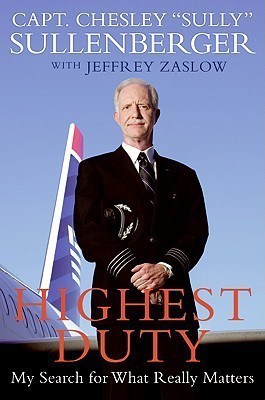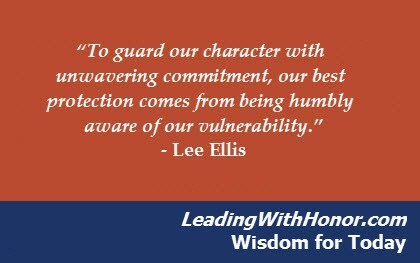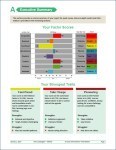Lee Ellis's Blog, page 314
February 25, 2015
The Latest Recommendation from Lee���s Bookshelf ��� ���Highest Duty: My Search for What Really Matters���
 The Latest Recommendation from Lee���s Bookshelf is Highest Duty: My Search for What Really Matters by Chesley B. Sullenberger and Jeffrey Zaslow. Even though this book was published several years ago, it has some great nuggets of wisdom from Sully Sullenberger.
The Latest Recommendation from Lee���s Bookshelf is Highest Duty: My Search for What Really Matters by Chesley B. Sullenberger and Jeffrey Zaslow. Even though this book was published several years ago, it has some great nuggets of wisdom from Sully Sullenberger.
In it, he reveals the important lessons that he learned through childhood, in his military service, and in his work as a commercial airline pilot. At heart, it is a story of hope and preparedness–that life���s challenges can be met if we���re ready for them. It���s also a great reminder that, even in these days filled with war, tragedy, and economic uncertainty, there are values still worth fighting for.
Many times, the best lessons learned are from those who are willing to share their experiences!
Click to read more about this inspiring book. And if you���ve already read this book, please share your thoughts and comments in this forum ���

February 24, 2015
Leadership Fill in the Blank – “The last time that I had to…”
Fill in the Blank ��� ���As a leader, the last time that I had to say ���no��� to someone was _________________.���
Please fill in the blank based on your recent experience, and share your answer in this forum – thank you!

February 23, 2015
FAQ – How Do You Deal With a Team Member(s) Who Isn���t Performing?
 As a leader, how do you deal with a team member(s) who isn���t performing up to expected levels? What���s the best way to handle it? Lee Ellis shares his 7 recommended steps in this FAQ ���
As a leader, how do you deal with a team member(s) who isn���t performing up to expected levels? What���s the best way to handle it? Lee Ellis shares his 7 recommended steps in this FAQ ���
Get the data and details straight so you have evidence.
Meet with the person and clarify expectations and ask why they are not being met.
Explain to the person what is required.
Provide coaching if needed.
Lay out the consequences if performance does not improve.
If performance does not improve, hold the person accountable by following through with the consequences.
Be respectful and discreet throughout the process. Caring and tough. Firm and fair.
Do you agree or disagree? Any additional steps that you have successfully used in the past? Please share your comments ���

February 22, 2015
On This Day in Leadership History, February 22, 2015
On this day in 1865, the state of Tennessee adopted a new constitution that abolished slavery. As we still witness the ups and downs of race relations in our nation today, imagine the strong leadership that it took to abolish the act of slavery while still in the last months of the Civil War.
Growing as a leader takes the willingness to accept new paradigms and ways of thinking. Where do you need to be more objective and grow as a leader? Choose to lead with this attitude in your family, team, or community!
Tennessee Constitution – Wikipedia

February 21, 2015
Monthly Leadership Coaching – Free Offer from Lee Ellis – See Inside
Everyone needs a coach���a trusted individual who can encourage and speak truth into you as a growing leader. As part of Lee���s passion for developing honorable leaders worldwide, he is now offering free monthly video coaching!
Simply sign up here, and automatically receive it each month in your inbox. If you���re already receiving these monthly coaching videos, please like and share ���

February 20, 2015
Leading with Honor Wisdom for Today, February 20, 2015
���To guard our character with unwavering commitment, our best protection comes from being humbly aware of our vulnerability.��� ��� Lee Ellis

February 19, 2015
How do Leaders Bounce Back During Times of Inexperience or Inferiority? Watch the Clip
Do you ever feel like your skills and experience are coming up short for the job that you���re called to do? How do you overcome those feelings of inexperience or inferiority? Be encouraged by Lee���s brief interview clip below as he shares how he bounced back to overcome his 6 year loss of experience after returning home from Vietnam. Please share with someone who needs this encouragement today!

February 18, 2015
Understanding How Natural Behavior Determines Ideal Team Structure: A Model for Leadership Success
(Editor���s Note: This month, we���re featuring guest author, Kriss Poll, who works with our strategic partner, DNA Behavior International��. She addresses the important topic of team collaboration and assessing natural behavior strengths in the team.)
By Kriss Poll
What does true collaboration look like?
From a 2008 Guide to Assessing Teamwork and Collaboration published by the Galileo Educational Network, ���Collaboration is a structured, recursive process where two or more people work together toward a common goal���typically an intellectual endeavor that is creative in nature���by sharing knowledge, learning and building consensus.���
Much of what we need to do in order to make an organization function requires us to work with other people. Traditionally, it takes time to learn how to interact with each person���s style, how to agree on the steps to take, roles and responsibilities, and individuals��� deadlines for a common goal. Managers incorporate various degrees of structure by defining roles and responsibilities, processes, project management, and methods of communication to complete the tasks to accomplish the goal.
There are various and differing opinions about how much structure strikes the right balance between helping to accomplish the goal efficiently and becoming a road block to productivity and creativity.
If not enough structure is in place, the team may be perceived as ineffective. Deliverables may not meet the expectations of the ���customer��� and/or leader(s) in terms of scope, quality, timeline, and/or budget.�� Often, in this low structure scenario, miscommunications occur.
Conversely, if there is too much structure, the team may be perceived as ineffective as well. In this scenario, it might be a time sink to go through all the process steps and the instructions may be so voluminous, people get lost and have trouble following the structure in place.�� In fact, too many meetings may take place that are focused more on the structure than on the goal, leaving a lull in initiatives moving forward.�� People may feel very restricted and disengaged and ultimately, Creativity is squashed.
For true collaboration within an organization or team, the structure and culture has to support two-way communication (creative conflict) built upon trust.
How much structure should you have in your organization?
Identifying the level of structure need in your organization depends on exploring a couple of key questions:
1) How big is your organization?
If you are a small company with just few people working together, less structure may be preferable. A company with fewer people requires each person to understand more of the bigger picture. They typically have to do many of the tasks themselves and there may be fewer interactions needed with other people.
If you are a growing or larger sized company, the more people you have, the more structure you may need in order to be effective. People may be added in order to handle higher volume. More people typically means that each person handles a smaller part of the bigger picture. People become specialized in their roles with specific tasks. The more interactions and hand-offs it takes to complete, the more guidelines and processes you may need to help everyone understand how to work together effectively.
2) What culture do you want to foster?
If you want to foster innovation and creativity, then you may want to have less detailed structure and more general high-level guidelines. Focus more on the goal you are trying to achieve, the communication channels needed to keep everyone in the loop, and fostering communication. Allow the team to figure out how to get to the end goal.
If your organization needs to foster nimbleness and an ability to react to changing customer demands, you also want to have less detailed structure and more high-level guidelines. Fewer restrictions allow employees to develop problem-solving skills in addressing customer issues quickly and foster engagement.
If your product has to be delivered precisely and there is no room for variability, then you will need more detailed structure and processes with step-by-step instructions.
If your organization is struggling with delivering and meeting expectations, then you will also need more detailed structure to help people stay on track. The detailed structure will hold people accountable for next steps /tasks and due dates, along with providing a more detailed analysis of the location of the breakdowns in the process and communications.
3) What are the natural behaviors of the people on the team?
If you have a team full of naturally take charge, spontaneous, and creative people, you will need at least a little structure to help keep them focused and productive. However, you don���t want to squash their natural strengths in problem solving, finding new or better solutions, and reacting instinctively to a dynamic business environment with too much structure.
If you have a team that is naturally very cooperative, planned, and anchored, they will need more structure to take advantage of their natural strengths of being able to follow instructions, ensure tasks are completed and results are delivered. These types of people are great at getting things done when the working environment is well-defined and there is less ambiguity.
Ideally the team would consist of a mix of traits that can provide for the proper balance of strengths to provide the best results.
How �� you add structure, and the culture you encourage, is important to fostering collaboration and creativity while still having enough structure to reduce miscommunication and issues and to ensure the outcome meets expectations.
KP
About the Author:
As Vice-President of Relationship Management Integration at DNA Behavior International��, Kriss Poll works with leaders to further develop their organizational goals and to build collaborative teams than can execute. For almost 20 years, she has worked as a seasoned leader and consultant with experience working in technology, operations, accounting and finance. She graduated with honors from Michigan State University with both her Bachelors in Accounting and an MBA with an emphasis in Information Systems and Finance. Learn more at www.DNABehavior.com.
~~~~~~~
Do you have the right level of structure in your organization? Having an accurate assessment of each team member���s natural behavior strengths and struggles will help determine leadership style, team structure, and ultimately save a lot of time and money as you achieve your organizational goals. Contact us for help and training.

February 17, 2015
New Lee Ellis Article ��� ���With a Succession Process, You���re Better Prepared for Future Growth���
How many situations have you witnessed where a local business or organization suffered because younger leaders weren���t trained to lead the organization? Or they catastrophically hired the wrong person for the wrong leadership position?
Whether it���s a family-owned business or Fortune 100 Corporation, a succession plan process to develop new leaders and prepare your organization for future growth is critical.
Click to read Lee���s latest article in Smart Business Magazine, and please share your comments ���

February 15, 2015
On This Day in Leadership History, February 15, 2015
On this day in 1946, Edith Houghton, at age 33, was signed as a baseball scout by the Philadelphia Phillies becoming the first female scout in the major leagues.
The world needs authentic people and leaders that follow their passion, interests, and natural strengths regardless of the obstacles! Don���t allow someone else to take the place where you are meant to be.











